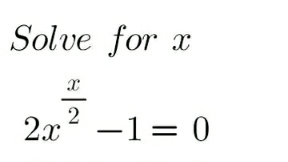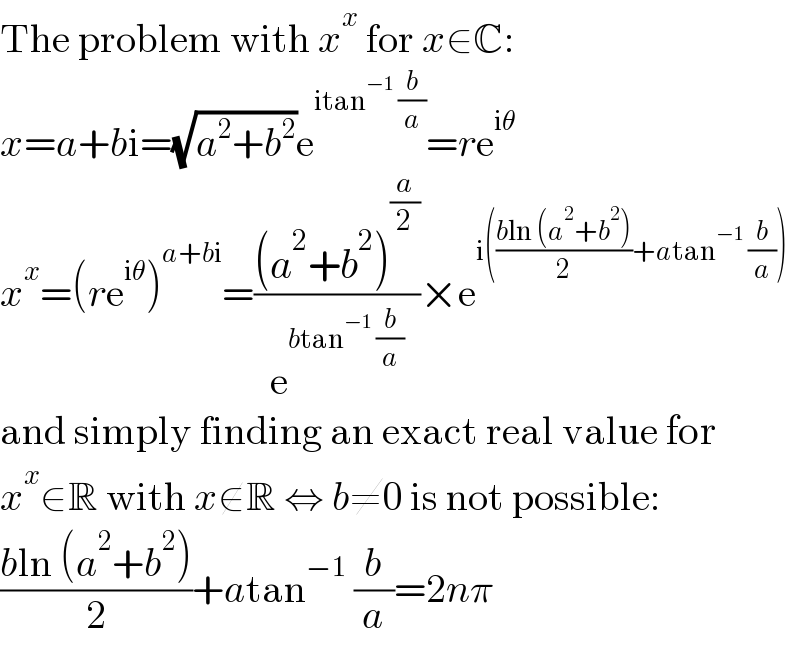
Question Number 195415 by Calculusboy last updated on 02/Aug/23

Answered by Frix last updated on 02/Aug/23

$$\mathrm{No}\:\mathrm{solution}\:\mathrm{exists}\:\mathrm{for}\:{x}\in\mathbb{C} \\ $$
Commented by Frix last updated on 03/Aug/23

$$\mathrm{Can}\:\mathrm{you}\:\mathrm{please}\:\mathrm{post}\:\mathrm{an}\:\mathrm{approximate} \\ $$$$\mathrm{solution}\:\in\mathbb{C} \\ $$
Commented by Calculusboy last updated on 03/Aug/23

$${thanks}\:{sir} \\ $$
Commented by mr W last updated on 03/Aug/23

$${you}\:{mean}\:{no}\:{solution}\:{exists}\:{for}\:{x}\notin{C}? \\ $$
Commented by Frix last updated on 04/Aug/23

$$...\mathrm{ok}\:\mathrm{I}\:\mathrm{was}\:\mathrm{wrong},\:\mathrm{I}\:\mathrm{just}\:\mathrm{tried}\:\mathrm{to}\:\mathrm{approximate} \\ $$$$\mathrm{and}\:\mathrm{got} \\ $$$${x}\approx.\mathrm{0535663}+.\mathrm{913581i} \\ $$
Commented by Frix last updated on 04/Aug/23

$$\mathrm{The}\:\mathrm{problem}\:\mathrm{with}\:{x}^{{x}} \:\mathrm{for}\:{x}\in\mathbb{C}: \\ $$$${x}={a}+{b}\mathrm{i}=\sqrt{{a}^{\mathrm{2}} +{b}^{\mathrm{2}} }\mathrm{e}^{\mathrm{itan}^{−\mathrm{1}} \:\frac{{b}}{{a}}} ={r}\mathrm{e}^{\mathrm{i}\theta} \\ $$$${x}^{{x}} =\left({r}\mathrm{e}^{\mathrm{i}\theta} \right)^{{a}+{b}\mathrm{i}} =\frac{\left({a}^{\mathrm{2}} +{b}^{\mathrm{2}} \right)^{\frac{{a}}{\mathrm{2}}} }{\mathrm{e}^{{b}\mathrm{tan}^{−\mathrm{1}} \:\frac{{b}}{{a}}} }×\mathrm{e}^{\mathrm{i}\left(\frac{{b}\mathrm{ln}\:\left({a}^{\mathrm{2}} +{b}^{\mathrm{2}} \right)}{\mathrm{2}}+{a}\mathrm{tan}^{−\mathrm{1}} \:\frac{{b}}{{a}}\right)} \\ $$$$\mathrm{and}\:\mathrm{simply}\:\mathrm{finding}\:\mathrm{an}\:\mathrm{exact}\:\mathrm{real}\:\mathrm{value}\:\mathrm{for} \\ $$$${x}^{{x}} \in\mathbb{R}\:\mathrm{with}\:{x}\notin\mathbb{R}\:\Leftrightarrow\:{b}\neq\mathrm{0}\:\mathrm{is}\:\mathrm{not}\:\mathrm{possible}: \\ $$$$\frac{{b}\mathrm{ln}\:\left({a}^{\mathrm{2}} +{b}^{\mathrm{2}} \right)}{\mathrm{2}}+{a}\mathrm{tan}^{−\mathrm{1}} \:\frac{{b}}{{a}}=\mathrm{2}{n}\pi \\ $$
